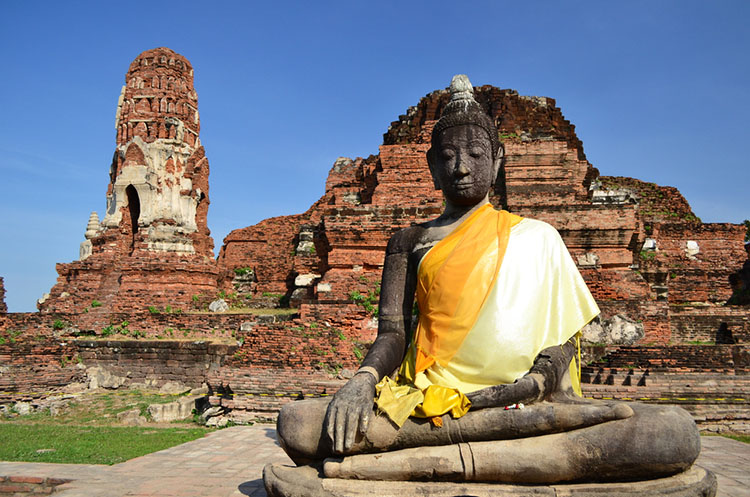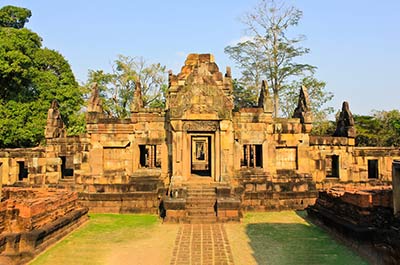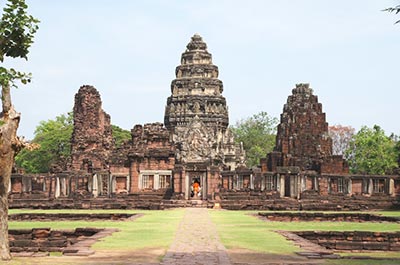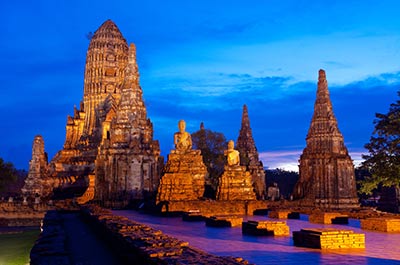
Historical landmarks
Famous historical sites in Thailand
The Kingdom of Thailand has a very long and rich history, dating back thousands of years to prehistoric times. Several empires and Kingdoms have ruled the country, leaving behind impressive landmarks and historical sites that still remain today.
Thailand has been inhabited for thousands of years. The earliest inhabitants during prehistoric times were hunters and gatherers. Between the 20th and 15th century BC early man started basic forms of farming and village construction.
A number of archaeological sites around the country provide evidence of human settlement during the Neolithic age, bronze age and iron age.
Earliest sites
Ban Chiang in Udon Thani province is one of Thailand’s best known prehistorical sites, that has become famous for its beautiful ceramic pottery that was found there. The site was inhabited for almost 2000 years and shows the transition of early man from Neolithic age into bronze and iron age.
Among the oldest sites in Thailand is Phu Phra Bat historical park in Udon Thani province. This forested sandstone hill contains traces of several cultures in different eras spanning thousands of years.
During prehistoric times early man left behind a number of rock paintings, later on the natural rocks and caves provided shelter for travelling monks during the early days of Buddhism. The remains of ancient Dvaravati era temples can still be found on the mountain. Around a thousand years ago the Khmer people carved out images of the Buddha in the rocks.
Ancient Buddhist structures
The oldest Buddhist structure in Thailand is the Phra Pathom Chedi in Nakhon Pathom. The history of the chedi goes back to the time when Buddhism was introduced in South East Asian countries, including Thailand. In the 3rd century BC the Indian emperor Ashoka sent out monks over large parts of Asia to spread Buddhism. The monks brought with them relics from the Buddha, that were enshrined into the Phra Pathom Chedi.
Khmer monuments in Thailand
Around 10 centuries ago when the Khmer empire controlled much of present day Thailand, a large number of Khmer temples were built, many of which remain in a well preserved state today.
Ancient highways were built to connect Angkor, the center of the Khmer empire, with other parts of the empire. Along one of these roads from Angkor to Phimai are three of the most impressive and best preserved Khmer temples in Thailand, namely Phanom Rung, Muang Tum and Phimai.
The Thai Kingdoms
Sukhothai
Sukhothai was the first independent Thai Kingdom. It reached its peak of power and prosperity during the 13th century. Today Sukhothai is a historical park containing a number of impressive landmarks. Sukhothai and its two sister cities, Si Satchanalai historical park and Kamphaeng Phet historical park are UNESCO World Heritage Sites.
Ayutthaya
Ayutthaya was one of the largest and richest cities in the world. Today the impressive remains of the city are well visited due to its location close to Bangkok. The Ayutthaya era came to an end in 1767, when most of the city was destroyed by Burmese invaders. The demise of Ayutthaya marked the start of the Rattanakosin era and the founding of Bangkok. The old part of Bangkok East of the Chao Phraya river was called Rattanakosin.
Rattanakosin
The first Rattanakosin King had a number of canals dug out and forts built to protect the city.
Among the first of Bangkok’s landmarks to be built were the Grand Palace, the Wat Pho and the Wat Arun with its impressive prang.





